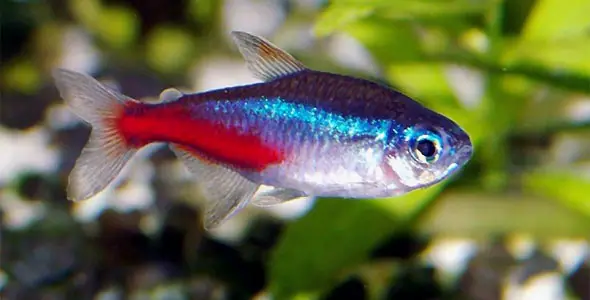Though they are nearly identical to the fierce and deadly Piranha, the Pacu is a peaceful omnivore. The most common variety of Pacu is the Red-Bellied Pacu, which can grow to be quite large. Though they can be somewhat aggressive in their younger years, they will mellow with age and make excellent tank companions. The Pacu is an incredibly large fish and as such requires an incredibly large tank; try 90 gallons or more. Though many may keep them as single fish, they enjoy the company of other Pacus. Make sure your Pacus have lots of places to hide.
The Red Bellied Pacu:
The Red Bellied Pacu, or Colossoma bidens, bears a resemblance to a number of other fish, including the deadly Pirahna. This has led to a number of misconceptions about them, as well as suffering from frequent cases of “mistaken identity”. The Red Bellied Pacu is not an herbivore, as some mistakenly believe, and does require some meat in its diet. It is not, however, a carnivorous beast like the Piranha and will not attack fish of equal or greater size. Like most omnivores, it is an opportunistic feeder and will eat fish that are small enough to be a mouthful. There are a number of rumors that Red-Bellied Pacus have attacked swimmers. However, with their constantly being mistaken for Piranhas, it is not unlikely that these stories are cases of mistaken identity.
Care:
Pacus create enormous amounts of waste and it is important that a good water filtration system is in place and that owners frequently change out the water. Neutral pH is important, but they can handle a range between 5.8-7.5. Pacus are easily frightened and when frightened will dart with amazing speed through the tank to safety. This can lead to water splashing out, broken equipment ,and destroyed decorations. Therefore, a long but shallow tank is recommended for Pacu owners. Remember, as omnivores they are opportunistic feeders, which means that live plants may be destroyed when the Pacu gets the urge to have a snack.
Diet:
Pacus are omnivores and require a diet that is high in both protein and vegetation. Fruits and vegetables dropped into the tank are an excellent treat. They will also eat cichlid pellets and koi pellets. Feeder fish, worms, and fish meat are excellent ways of providing protein.
Size: 20 Inches
Freshwater/ Saltwater: Freshwater
Diet: Omnivore
Reef Compatibility: NA
Tank Mate Compatibility: 7
Lifespan: Up to 15 Years




